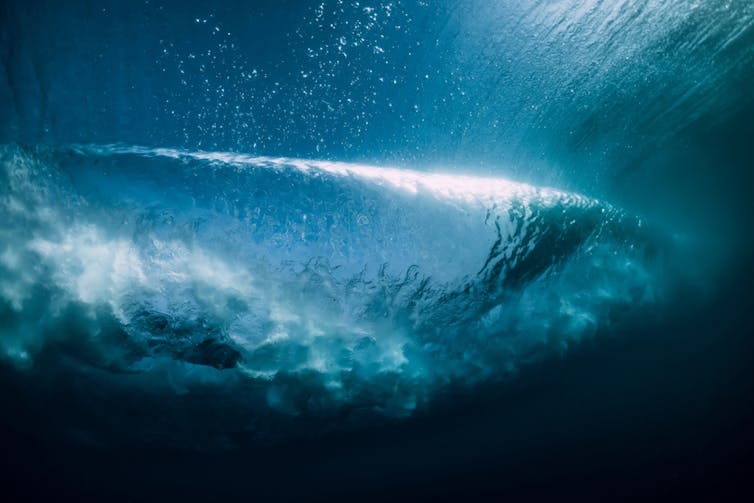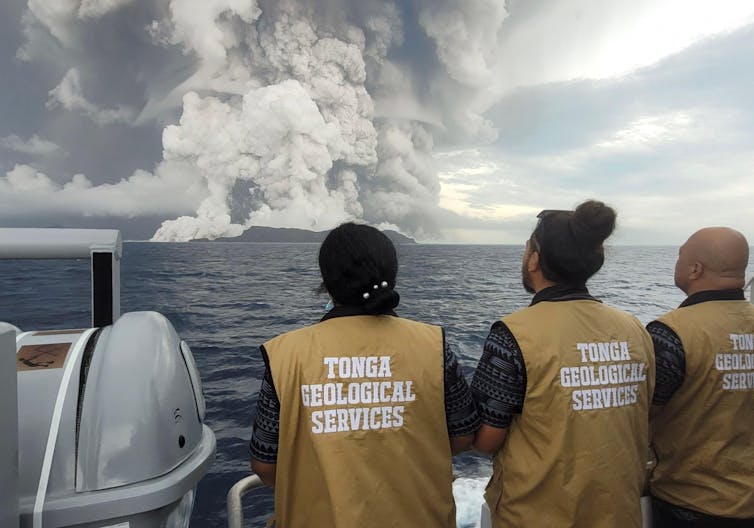Wave energy’s huge potential could finally be unlocked by the power of sound
April 6, 2025
Ocean waves have long been seen as having huge potential as a source of renewable energy. Waves produce an estimated 50 trillion to 80 trillion watts of power worldwide – nearly two to three times the world’s current annual energy consumption.
Many devices have been designed to capture and convert waves’ great power into electricity, but today’s technologies face challenges in efficiency, particularly in deeper waters. As a result, wave energy hasn’t yet taken off as a renewable source in the same way as wind and solar.
One way around this problem lies in the interaction between two types of waves: those on the ocean’s surface, and those that reside underwater. My research group has just published a paper demonstrating how underwater sound waves can be used to make surface waves more powerful, potentially making them a more viable source of energy.
The same insights could also eventually be used to reduce the risks of tsunamis by making them smaller. In addition, in a second new paper we show how underwater waves can be used to improve today’s tsunami early-warning system.
The waves on the surface of the ocean are often created by a combination of wind raising up water and gravity pulling it back down – hence they’re sometimes referred to as surface-gravity waves. On the other hand, their underwater counterparts are sound waves produced by phenomena like earthquakes or volcanic eruptions, sometimes thousands of metres below the surface.
These acoustic waves travel by compressing and expanding the water, similar to how sound moves through the air. They travel across transoceanic distances at the speed of sound in the water (around 1,500 metres per second) before eventually dissipatin. Surface waves travel at much lower speeds, in the order of tens of metres per second.
In classical water wave theory, these two types of waves are considered separate entities, each living in its own world at its own rhythm. The possibility of them interacting only arose on the back of a 2013 research paper that I co-authored, which prompted my colleagues and I to research a phenomenon known as triad resonance.
This is where two acoustic waves transfer energy to a surface wave by matching its frequency, which in turn causes the surface wave to get larger and more powerful (by increasing its amplitude). This opens up the possibility of using an acoustic wave generator to generate sound waves tuned to a particular size and frequency that would enhance (or equally suppress) surface waves.
Enhanced waves would enable today’s wave turbines and oscillating water columns (which use wave power to force air through a turbine) to produce more electricity, effectively overcoming their efficiency problem.

Wonderful Nature
The main requirement would be an acoustic wave generator that could be finely tuned at the required scale. Acoustic wave generators already exist for laboratory purposes, so it’s a question of scaling up an existing technology.
Our research findings show that triad resonance can increase surface wave heights by more than 30%. Of course, the generator would require energy, though the hope is that this too could be powered by waves to minimise carbon emissions. One additional challenge is to ensure that methods are developed to use the acoustic energy efficiently to ensure that the least possible energy is wasted.
Our next step is to produce some more numerical simulations and to conduct a series of small-scale laboratory experiments looking at how triad resonance works in practice. These will help refine our theories and assess their feasibility, hopefully with a view to turning this into a commercial reality.
I originally suggested the possibility of reducing the height of tsunami waves by manipulating underwater acoustic waves back in 2017. In the new paper, we look at this in more detail.
We found that the resonance mechanism certainly took place at an oceanic scale during the 2022 Tonga earthquake and tsunami. This shows that it’s theoretically possible to manipulate the size of a tsunami using our technique.

Zuma Press, Inc.
The challenge lies in generating and directing the acoustic waves at the required scale and configuration in real-world conditions. This would be more challenging than using acoustic waves to help harness wave energy, not least because of the scale of tsunamis, which would necessitate a much more powerful acoustic-wave generator.
Other issues to overcome would be knowing the exact properties of the tsunami in real time, and the risk that using the wrong configurations could actually make the wave bigger instead of smaller.
While it could take some time to make this feasible, acoustic waves can also potentially help to mitigate tsunamis in a different way. Our second paper demonstrates that monitoring and analysing these waves in real time could complement the existing and emerging technologies for predicting tsunamis, including ocean buoys and seismometers.
There are currently thousands of seismometers deployed around the world, but they only monitor earthquakes, whereas tsunamis can also be caused by landslides, explosions and volcanic eruptions. Even with earthquakes, large seismic readings don’t always entail large tsunamis. This can lead to false alarms, such as in Alaska in 2018.
Meanwhile ocean buoys, which measure sea levels and water pressure, are often faulty because of their operating conditions, and also relatively slow at giving warnings when tsunamis (according to my calculations) can move at speeds of up to 200m per second in the deep ocean.
A complementary system is to measure acoustic waves using an underwater microphone known as a hydrophone. These capture the acoustic waves created by all of the phenomena that cause tsunamis, and the speed at which these waves travel means that just 30 hydrophone stations could cover the entire world’s tsunami high risk areas.
This could be particularly life-saving for coastal communities near the source of a tsunami. It would also support global goals for more resilient coastal cities, such as Unesco’s aim to make all such places “tsunami ready” by 2030.
Search
RECENT PRESS RELEASES
Related Post


